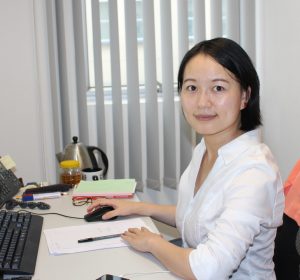Studying hydrodynamic and modelling of hazard processes
Assistant Professor Gao Liang is from the Department of Civil and Environmental Engineering (CEE) of FST, she is also one of the research members of the State Key Laboratory of Smart City Internet of Things (SKL-IoTSC) and the Centre for Regional Oceans. Due to climate change and the rise of sea levels, extreme weathers like floods and storm surges appear to be more frequent. Except for coastal city like Macau usually hit by typhoon, mainland city like Beijing is also facing the challenges of floods and heavy rains. Prof Gao who lived in Beijing before is more concerned about urban safety issues. Her research interests are related to urban public safety and disaster prevention. She hopes the disaster simulation model can enhance city’s flexibility and adaptability in the face of disaster risk.
Numerical simulation assists disaster prevention
Before joining the University of Macau, Prof Gao worked as a researcher at Zhejiang Institute of Hydraulic and Estuary. Spending two years in disaster prevention, hydraulic research and consulting, she finally decided to pursue further studies in this field. After graduating from the Hong Kong University of Science and Technology in 2016, she served as a postdoctoral fellow at the Hong Kong University of Science and Technology and the National weather center of the University of Oklahoma. In regards of the impact of tropical cyclones and storm surges in Macau, Prof Gao said that numerical simulations including drainage pipe network simulation, rainfall simulation, typhoon intensity simulation could be applied to measure the number of casualties under extreme weather, and the damage to houses and roads. ‘Taking the typhoon Hato in 2017 as an example, the simulation model can forecast what would happen after inputting the path, wind speed and tide of the typhoon. Thereby, local residents could have quick response and emergency measures of the disaster, such as shutting down the power station, planning the escape route and safety zone in advance’ Prof Gao says. Only when the city has capacity to resolve these problems, it can recover quickly and will not endanger the future development.
All efforts are not made for nothing
Although the damage of city can be forecasted , there are many challenges have to be overcome in order to successfully apply the simulation model into use according to Prof Gao. For example, the data in a database must be accurate, as well as the timely release of results. Prof Gao shared her attitude in regards of handing these challenges, ‘All efforts are not made for nothing’, Prof Gao says. ‘Just as every flower blooms in its own time, sometimes you may not see the immediate results of your work. But every effort you made right now will be rewarded in the future, so no need to pay too much attention to personal gains and losses,’ she says. Recently, Prof Gao’s related research received more than MOP 1.5 million from the Macau Science and Technology Development Fund (FDCT)(file no: 0030/2020/A1). The bloomsome of the flower has given a booster for Prof Gao’s long effort. She hopes to continuously optimize the simulation model in the future so as to create a satisfied result for herself and her students.
專注水動力及災害模擬的研究
高亮教授是科技學院土木及環境工程系的助理教授,同時也是智慧城市物聯網國家重點實驗室及海洋區域研究中心的研究成員之一。隨著氣候變遷海平面上升,特大暴風、洪水及風暴潮越見頻繁。除了澳門這些受台風吹襲的沿海城市,內地城市如北京也同樣面臨洪水暴雨等風險,早年在北京生活的高教授比較關注城市安全問題,她的研究重點是城市公共安全與災害防治,期望能透過災害模擬情景,增強城市的彈性及適應力。
數值模擬協助防災
加入澳大前,高教授曾任職浙江省水利河口研究院,兩年的防災減災、水工水力學研究及諮詢工作令高教授決心在這個領域上努力鑽研,最終選擇到香港科技大學升讀土木工程博士,2016年畢業後,曾任香港科技大學博士後研究員及美國俄克拉荷馬大學國家氣象中心博士後研究員。對於澳門經常面臨熱帶氣旋、風暴潮等災害,高教授表示可以透過數值模擬包括排水管網模擬、降雨模擬、台風強度模擬等測量極端天氣下的傷亡人數,房屋及道路損毀情況。她分享說:「以2017年天鴿風災為例,在模型中輸入台風的路徑、風力、潮汐就可以判定即將發生什麼情況,然後做出適當的應急措施, 如關閉發電站、預先規劃好逃生路線及安全區。」當城市有足夠能力化解這些變化時,即使遇上大災難也能快速恢復,不危及未來發展。
功不唐捐
要成功運用模型分析也要克服不少挑戰,如收集的數據必須準確,分析結果也需及時。在解決這些難題上,高教授同樣分享了她的處事態度,她勉勵學生“功不唐捐”: 「並不是每次鑽研,都能馬上有成果,走了彎路也不必介懷,今天種下的種子會在意想不到的時候開花結果,每次努力都會有所獲益,因此不必計較一時得失。」不久前高教授相關的研究獲得了澳門科學技術發展基金 (FDCT) 超過150萬澳門元的資助 (檔案號碼是0030/2020/A1),種子的成長為高教授打下強心針,未來她希望能不斷優化模型,創造出令自己和學生都滿意的佳績。

Professor Gao Liang shared her
research and experiences
高亮教授分享她的研究及心得

